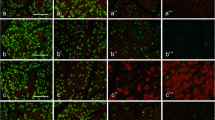Abstract
The secretory cell types of the hamster Harderian glands were studied in both male and female Syrian hamsters. As previously demonstrated, female hamsters showed a single secretory cell type (type I), while male hamsters displayed two secretory cell types (type I and type II). Type-II cells were observed after the first month of age correlating with the increase in testosterone levels. The administration of testosterone to adult female hamsters resulted in a marked increase in the percentage of type-II cells without a significant increase in the number of mitotic figures. Very low levels of serum testosterone were able to maintain the percentage of type-II cells. Castration of male hamsters produced a decrease in the percentage of type-II cells. This drop correlated with the reduction in serum testosterone levels. The chronic administration of a luteinizing hormone-releasing hormone agonist to male Syrian hamsters induced a significant reduction in both serum luteinizing hormone and testosterone. However, the percentage of type-II cells was similar to that of control hamsters suggesting that very low levels of circulating testosterone are able to maintain the percentage of type-II cells. In a final experiment male Syrian hamsters were treated with the antiadrogen cyproterone acetate. No changes were observed in the percentage of type-II cells, whereas serum luteinizing hormone and testosterone levels were significantly modified. We concluded that (1) type-II cells differentiate from type-I cells; (2) gonadal androgens are the major factor controlling this differentiation; and (3) the disappearance of type-II cells after androgen deprivation occurs through holocrine and apocrine mechanisms. The possible implication of 5α-reductase in the regulation of secretory cell types in the Harderian glands of hamsters is discussed.
Similar content being viewed by others
References
Bucana CD, Nadakavukaren MJ (1972) Fine structure of the hamster Harderian gland. Z Zellforsch Mikrosk Anat 129:178–187
Bucana CD, Nadakavukaren MJ (1973) Ultrastructural investigation of the postnatal development of the hamster Harderian gland. Z Zellforsch Mikrosk Anat 142:1–12
Buzzell GR, Menendez-Pelaez A, Porkka-Heiskanen T, Pangerl A, Pangerl B, Vaughan MK, Reiter RJ (1989) Bromocriptine prevents the castration-induced rise in prophyrin concentration in the Harderian glands of the male Syrian hamster, Mesocricetus auratus. J Exp Zool 249:172–176
Hoffman RA (1971) Influence of some endocrine glands, hormones and blindling on the histology and porphyrins of the Harderian glands of golden hamsters. Am J Anat 132:463–478
Hoffman RA, Johnson LB, Reiter RJ (1985) Harderian glands of golden hamsters: temporal and sexual differences in immunoreactive melatonin. J Pineal Res 2:161–167
Lopez JM, Tolivia J, Diaz C, Alvarez-Uria M (1990) Ultrastructural study of lamellar and nucleolus-like bodies in the Harderian gland during postnatal development of the hamster (Mesocricetus auratus). Anat Rec 228:247–254
Lopez JM, Tolivia J, Alvarez-Uria M (1992) Postnatal development of the Harderian gland in the Syrian hamster (Mesocricetus auratus): a light and electron microscopic study. Anat Rec 233:597–616
Mainwaring WIP (1977) Modes of action of antiandrogens: a survey. In: Martini L, Motta M (eds) Androgens and antiandrogens, Raven Press, New York, pp 151–161
Marrufo B, Menendez-Pelaez A, Buzzell GR, Gonzalez-Brito A, Reiter RJ (1989) 5α-Dihydrotestosterone administration converts indoleamine metabolism and porphyrin content of the female Syrian hamster Harderian gland to the male type. Proc Soc Exp Biol Med 192:192–195
Menendez-Pelaez A, Buzzell GR, Gonzalez-Brito A, Reiter RJ (1990) Androgenic control of N-acetyltransferase activity in the Harderian glands of the Syrian hamster in mediated by 5α-dihydrotestosterone. J Cell Biochem 42:95–100
Menendez-Pelaez A, Rodriguez C, Dominguez P (1991) 5-Aminolevulinate synthase mRNA levels in the Harderian gland of Syrian hamsters: correlation with porphyrin concentrations and regulation by androgens and melatonin. Mol Cell Endocrinol 80:177–182
Payne AP, McGadey J, Moore MR, Thompson GG (1977) Androgenic control of the Harderian gland in the male golden hamsters. J Endocrinol 75:73–82
Rodriguez-Colunga MJ, Fernandez C, Antolin I, Rodriguez C, Tolivia D, Menendez-Pelaez A (1991) Chronic administration of melatonin induces changes in porphyrins and in the histology of male and female hamster Harderian gland: interrelation with the gonadal status. J Pineal Res 11:42–48
Rodriguez-Colunga MJ, Fernandez C, Rodriguez C, Tolivia D, Menendez-Pelaez A (1992) Female Syrian hamster Harderian gland: development and effects of high environmental temperature and melatonin injections on histology and porphyrin deposits. Anat Rec 232:393–300
Schally AV, Coy DH, Arimura A (1980) LH-RH agonists and antagonists. Int J Gynecol Obstet Biol Reprod (Paris) 18:318–324
Sheridan PJ (1991) Can a single androgen receptor fill the bill? Mol Cell Endocrinol 76:39–45
Spike RC, Johnston HS, McGadey J, Moore MR, Thompson GG, Payne AP (1986) Quantitative studies on the effects of hormones on structure and porphyrin biosynthesis in the Harderian gland of the female golden hamster. II. The time course of changes after ovariectomy. J Anat 145:67–77
Thiessen DD (1988) Body temperature and grooming in the Mongolian gerbil. Ann NY Acad Sci 525:27–39
Vaughan MK, Richardson BA, Petterborg LJ, Vaughan GM, Reiter RJ (1986) Reproductive effects of 6-chloromelatonin implants and/or injections in male and female Syrian hamsters (Mesocricetus auratus). J Reprod Fertil 78:381–387
Vilchis F, Perez-Palacios G (1989) Steroid hormone receptors and the sexual phenotype of the Harderian gland in hamsters. J Endocrinol 121:149–156
Author information
Authors and Affiliations
Rights and permissions
About this article
Cite this article
Rodríguez-Colunga, M.J., Rodríguez, C., Antolín, I. et al. Development and androgen regulation of the secretory cell types of the Syrian hamster (Mesocricetus auratus) Harderian gland. Cell Tissue Res 274, 189–197 (1993). https://doi.org/10.1007/BF00328000
Received:
Accepted:
Issue Date:
DOI: https://doi.org/10.1007/BF00328000




